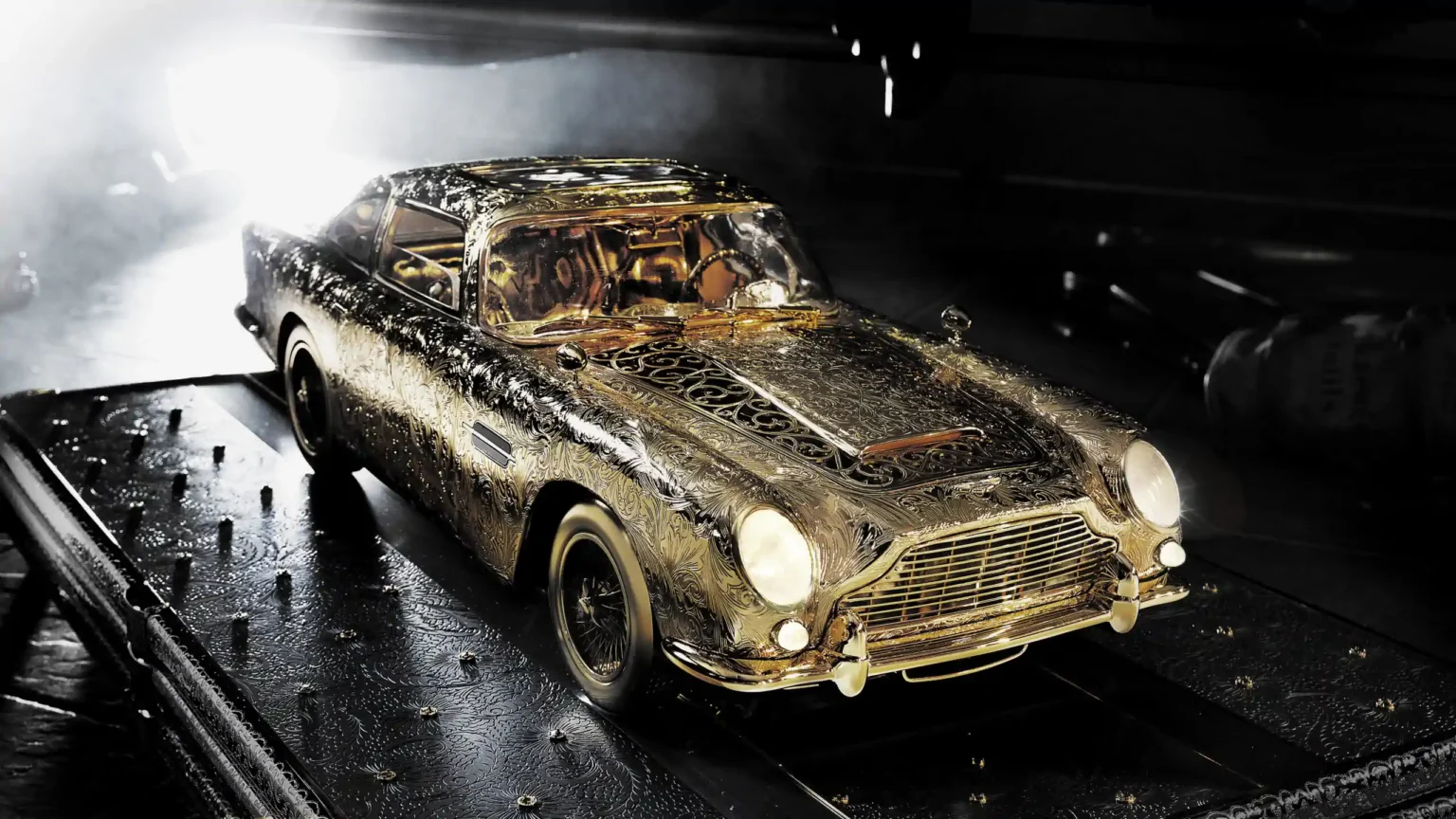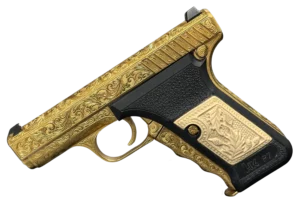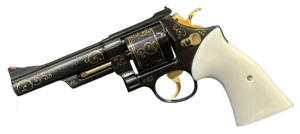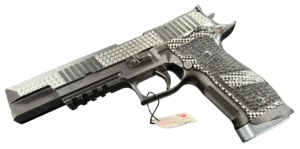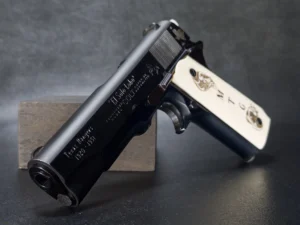Key Takeaways:
- Mueller Murgenthal doesn’t just craft objects—they tell stories through metal, wood, and design.
- Every piece from the House of Mueller Murgenthal is more than a product. It’s a narrative etched in silver, engraved in steel, and shaped by hand. Whether it’s a precision pistol or a ceremonial dagger, you’re not just holding craftsmanship—you’re holding meaning. There’s heritage behind the blade, intention behind every engraved line, and a quiet sense of legacy built into the weight of it all. That’s what sets them apart: they don’t decorate—they articulate.
- Collaborations with legends like Korth and SIG Sauer show that beauty and performance aren’t mutually exclusive.
- Let’s be real, form and function don’t always get along in the firearms world. But when German engineering meets Swiss artistry, you get something rare: machines built to perform and designed to awe. These aren’t museum pieces that sit idle. They fire. They function. But they also leave an impression long after the shooting stops. With each collaboration, Mueller Murgenthal proves you don’t have to choose between precision and presence—you can have both, and then some.
- Exclusivity isn’t a gimmick—it’s the natural result of a process that refuses to rush.
- Mueller Murgenthal doesn’t do volume. And frankly, they don’t need to. Their limited runs aren’t about hype—they’re about honoring the time it takes to make something unforgettable. One blade might take weeks. A custom-engraved pistol? Maybe months. But that’s the point. These aren’t things you “buy.” They’re things you acquire, treasure, and maybe, if you’re lucky, pass down. Rarity here isn’t scarcity for the sake of it—it’s the cost of doing it right.
If you’ve ever stumbled upon a piece of craftsmanship so refined it made you stop and stare, there’s a chance it came from the House of Mueller Murgenthal. Tucked away in the peaceful town of Murgenthal, Switzerland—yes, the kind of place that looks like it was plucked straight from a postcard—this house isn’t just about making beautiful things. It’s about elevating utility into artistry. And they’ve been doing it for generations.
At its core, Mueller Murgenthal is known for blending traditional silversmithing with modern expression. Sounds simple, right? But the result is anything but. Whether it’s an ornate dagger, a sculpted firearm, or a luxurious objet d’art, their work feels less like a product and more like a legacy—each piece a living memory wrapped in silver, gold, and timeless design.
And leading the charge in modern times? Vivian Mueller. A name you’ll want to remember. He didn’t just preserve tradition; he reimagined it with a visionary’s flair.
It All Began in a Small Swiss Workshop
Let’s rewind for a second. The origins of the House of Mueller Murgenthal reach back to the 19th century, when the Mueller family first picked up their hammers and files—not to create firearms or collector-grade sculptures, but to master the delicate, time-honored craft of silversmithing.
Back then, silversmithing wasn’t just a job. It was a calling, a community trade passed down like heirlooms. In Murgenthal—a region already admired for its artisanal skill—this mattered. The Muellers built their reputation slowly, not with fanfare, but with quiet consistency. The kind of consistency that speaks through polish, weight, and feel. Customers noticed—word spread.
But as times changed, so did the possibilities. The Swiss industrial boom brought in machines and innovation, and the Muellers didn’t shy away from it. Instead, they fused new techniques with old-world methods. Think of it like remixing a classical piece with modern beats—it still honors the melody, but suddenly it hits a little differently.
By the early 20th century, the family began exploring the idea of transforming not just silverware or jewelry, but functional items into works of high art. The biggest leap? Firearms. What started as a passion for form and function evolved into a distinctive style.
Some major turning points along the way:
- Mastering traditional silversmithing with unmatched finesse
- Collaborating across borders with leading designers and brands
- Expanding from decorative arts into high-end firearms and sculpture
- Getting recognized not just for what they made, but how they made it
By mid-century, their evolution was complete. Mueller Murgenthal wasn’t just a family shop anymore. It was a global name in luxury design, known for pushing boundaries while staying grounded in authenticity.
Forged in Silver: The Craft That Started It All
Now, before we talk about luxury pistols and dagger-sculptures, we have to appreciate the core: silversmithing. It’s where the House of Mueller Murgenthal honed its soul.
For the Muellers, silver wasn’t just a medium—it was a language. One spoken through hammer taps, engraved curls, and mirror-smooth finishes. Each piece they crafted wasn’t just beautiful; it had a tactile personality. It caught light just right. It felt balanced in the hand. It whispered luxury, not screamed it.
Silversmithing, after all, isn’t about flash. It’s about subtlety, patience, and understanding how a tiny flourish can transform something ordinary into something unforgettable. This philosophy still guides the house’s creative process—even when they’re working with materials like steel, gold, or exotic woods today.
Some hallmarks of their silversmithing tradition:
- Hyper-detailed patterning and ornamental flourishes
- Materials selected as much for feel as for visual appeal
- A blend of handcraft and cutting-edge tools (without losing the “human touch”)
- Surfaces so polished, they could double as mirrors
And let’s be honest—when someone can make a serving spoon feel like a sculpture, imagine what they can do with a blade or a pistol. That’s the kind of magic the Muellers bring to every project.
Vivian Mueller: Craftsman, Leader, Visionary
Fast-forward to modern times, and you’ll find Vivian Mueller as the guiding force who brought fresh energy to a time-honored house. Vivian wasn’t just a steward of tradition—he was a bold, creative with a reverence for history and an eye for the future.
Raised in the family trade and deeply involved in its evolution, Vivian brought a thoughtful intensity to every aspect of the house. He didn’t just maintain its standards; he pushed them higher. Under his watch, Mueller Murgenthal stepped confidently into new creative territory—from daring firearm collaborations to boundary-pushing sculptures.
Vivian’s signature approach? Uniting depth with daring. His work emphasized symbolism, harmony in contrast, and a commitment to telling stories through form. You could sense it in the details—how one curve balanced a sharp angle, how every engraving seemed to carry weight and meaning.
But just as important was his leadership style. Vivian encouraged input at every level. His workshop wasn’t about hierarchy—it was about harmony. Engravers, metalsmiths, designers… they weren’t just executing his ideas—they were co-creators.
And that’s maybe the most significant part of his legacy: not just what he created, but how he inspired others to create with purpose, skill, and pride.
Murgenthal, Switzerland: Where Precision Lives and Breathes
Picture this: snow-dusted rooftops, alpine air so crisp you could bottle it, and a town so quiet you can hear the rhythm of a hammer in a metal shop from blocks away. That’s Murgenthal—a small Swiss village with an outsized reputation, thanks in no small part to the House of Mueller Murgenthal.
It’s more than just a backdrop. This town shapes the house’s very identity. The kind of precision Switzerland is known for—clockwork, chocolate, craftsmanship—runs through Murgenthal’s veins. And when you step inside Mueller’s workshop, it hits you: the surroundings matter. You can see how the stillness outside becomes the calm focus inside, where artisans tune in and shut out distraction.
This place isn’t just scenic—it’s a breeding ground for excellence. There’s an unspoken expectation around here that if you’re going to make something, it better be worth passing down. That philosophy echoes in every polished curve and engraved detail.
The house thrives on this energy. The inspiration drawn from Murgenthal’s natural beauty and disciplined spirit isn’t theoretical—it’s real. It guides every piece they produce. Whether it’s a blade, a sculpture, or a finely engraved pistol, there’s a distinct Swiss signature to it: understated but unforgettable.
When Firearms Become Art: Beauty Meets Function
Let’s be honest—when most people think of firearms, “aesthetic” probably isn’t the first word that comes to mind. But that’s where the House of Mueller Murgenthal flips the script. They’ve taken something built for function and elevated it into something that stops people in their tracks. It’s not about glamorizing weapons; it’s about asking a simple, powerful question: why can’t something be both valuable and beautiful?
To Mueller Murgenthal, a firearm is a blank canvas. The form is already striking—metal, movement, balance. What they do is draw out that potential with engraving, inlay, and meticulous detailing. They don’t just decorate—they reinterpret.
From the moment the design begins to take shape, it’s personal. Sketches are passed around. Adjustments are debated. Every swirl of silver, every gold leaf or pearl grip has a reason for being. Sometimes the design tells a story of heritage, of craftsmanship, of a cultural motif. Other times, it’s purely an expression of balance and beauty.
A few characteristics that set their firearms apart:
- Engravings with real symbolism—think folklore, mythology, historical nods
- Precious metals used with restraint and purpose
- Seamless blend of mechanical engineering and handcraft
- Finished pieces that still function flawlessly on the range
And the result? Pieces that make you hesitate before picking them up—not because they’re fragile, but because they’re art.
They aren’t just admired by gun enthusiasts either. Collectors from the worlds of fine art and design seek these out for their dual nature. It’s that fusion of craft and concept, of grit and glamour, that makes these firearms impossible to forget.
Echoes of Fabergé: A Touch of Imperial Grandeur
Here’s a fun twist: when you look closely at some Mueller Murgenthal creations, you might think you’ve stepped into the Fabergé workshop of old Russia. That’s not by accident.
Peter Carl Fabergé—famous for those decadent jeweled eggs—was a master of ornamentation, a craftsman who believed even the smallest object could carry the weight of opulence. The House of Mueller Murgenthal has taken that philosophy and applied it to firearms, daggers, and sculpture.
And no, we’re not talking about gaudy overkill. This isn’t about drowning pieces in gemstones or making things flashy for the sake of it. Instead, it’s about achieving that Fabergé-style complexity—layered design, rich symbolism, and unapologetic beauty. They embrace the same attitude: if you’re going to make something, make it meaningful… and make it magnificent.
Where the influence shines:
- Elaborate layering in surface patterns—like looking into a fractal
- Rare materials (but only where they heighten meaning or mood)
- Hidden details meant to surprise the observant eye
- Designs that lean into luxury while still feeling grounded in craftsmanship
It’s an homage, not a copy. A Fabergé pistol might sound over-the-top—but in Mueller’s hands, it becomes refined, focused, and wholly original. A celebration of art history, quietly whispering through Swiss steel.
Daggers, Reimagined: Steel with a Soul
Now, let’s talk blades—specifically, daggers. At Mueller Murgenthal, a dagger isn’t just a tool or a weapon. It’s a sculpture. A symbol. A story forged in steel.
Historically, daggers have always carried symbolic weight. Ceremonial, sacred, even mythological. The house leans heavily into that legacy. They don’t just build blades—they channel something ancient and instinctive into each one.
These aren’t standard hunting knives or wall decorations. They’re complex works of art. Some have swirling Damascus patterns that seem to move under light. Others are set with rare woods or metals. Some are delicate. Others feel like heirlooms from an empire that never was.
Standout features of their dagger work:
- Hand-forged blades shaped with sculptural intent
- Handle materials that range from exotic hardwood to fossilized ivory
- Engraving not just on the blade, but on fittings, guards, and pommels
- Pieces that are balanced—not just for handling, but visually too
There’s always a story tucked in these blades. Maybe it’s cultural, drawn from Norse mythology or medieval heraldry. Perhaps it’s personal, tied to a commission or collector’s vision. But whatever the theme, the house brings it to life with a reverence few makers can match.
These daggers are often passed from hand to hand at shows and galleries with the kind of hush you hear in a museum. Because once you see one, it’s not just another knife. It’s an artifact—etched with intention, and shaped with the same care you’d expect from a sculptor working in marble.
Beyond the Barrel: When Art Leaves the Firearm Behind
You might know Mueller Murgenthal for their firearms or blades—but honestly, that’s only part of the story. Their creative range stretches far beyond functional forms. Some of their most evocative work? Pure sculpture. No trigger, no edge—shape, story, and soul.
Their sculptures aren’t churned out. Each one is a meditation on form, texture, and emotion. Some are literal—animals, mythic figures, or natural elements frozen in motion. Others are abstract, bending metal into tension and grace. But every piece? Intentional.
They work with everything from polished bronze and forged steel to raw, patinated alloys that appear to have survived centuries. And even when a piece is non-functional, you can still spot the Mueller signature—precision, balance, a sense of weight that draws the eye and anchors the room.
Themes you’ll often find woven through their sculptural work:
- Nature as power—wings, claws, coiled serpents
- Human form and motion, abstracted but emotionally charged
- Materials layered for visual contrast: matte vs gloss, steel vs stone
- Sculptures that feel like they’re caught in a moment of becoming
The common thread? Every work feels like it has a backstory, even if it doesn’t spell it out. It’s art that invites you to fill in the blanks. And that, more than anything, is what keeps collectors coming back.
When German Precision Meets Swiss Soul: Korth Collaborations
Now, if you’re into fine firearms, the name Korth probably rings a bell. German-made, mechanically perfect, and famously rare, Korth revolvers are the kind of guns that engineers daydream about. So, when they teamed up with the House of Mueller Murgenthal, something remarkable happened.
It was like pairing a concert pianist with a master violin maker—each precise on their own, but together? Harmonious. Korth brought the mechanics: tight tolerances, flawless internals, and rock-solid reliability. Mueller brought the beauty: sculpted frames, elaborate engravings, and finishes that turned heads.
The result? Collectors were stunned. These weren’t just revolvers—they were centerpieces.
Some highlights from the Korth x Mueller Murgenthal pairing:
- Ultra-limited editions—often single-digit production runs
- Bold finishes: deep blues, brushed silver, polished black
- Engravings that told stories—dragons, eagles, and floral motifs
- Functionality that matched aesthetics (yes, they shoot beautifully)
What made these collaborations special wasn’t just the detail. It was the philosophy. Both Korth and Mueller Murgenthal operate with a similar mindset: to make it perfect, lasting, and matter. Their shared DNA made the collaboration feel natural, like they’d been building toward it all along.
Today, these joint pieces are collectors’ holy grails. They’re not just rare—they’re revered.
SIG Sauer: Where Innovation Meets Indulgence
While Korth leaned towards traditional and mechanical approaches, SIG Sauer brought a different kind of energy to the table: tactical precision combined with forward-thinking engineering. Think polymer frames, modular systems, and performance-driven design. And yet, when SIG paired up with Mueller Murgenthal, the result was every bit as refined.
This wasn’t just a one-off project. It was a full embrace of what happens when modern firearm function gets dressed in couture. These were SIGs—but unlike any you’d seen before.
The house took models like the P226 and transformed them into works of art. Same internals. Same legendary SIG reliability. But now? Dressed in bespoke hand-engraved slides, with luxury grips and precious metal inlays.
Standout details in the SIG x Mueller Murgenthal collection:
- Custom scrollwork and motif-driven engravings
- Dual-tone finishes that catch light in mesmerizing ways
- Luxury-grade grip materials: cocobolo, ebony, ivory
- Serial-numbered collector runs with full provenance
It was a bold move—pairing a modern tactical platform with old-world artistry. But it worked. And collectors responded. These weren’t pieces made for the duty belt—they were made for the velvet-lined case.
And yet, that duality remained: beauty and performance, together in one frame.
The Art of the Process: From Spark to Sculpture
Ever wonder how a piece from Mueller Murgenthal comes to life? It’s not fast. It’s not cheap. But it is fascinating.
Everything starts with a concept—usually born from a conversation, a memory, or even a dream. Sometimes, a collector comes with a theme. Other times, the house knows it’s time to explore something new.
From there, the design team starts sketching. But we’re not talking napkin doodles—these are serious, multi-angle, dimensionally accurate renderings. Think blueprint meets mood board. They test materials, refine dimensions, and explore finishes.
Then comes the real magic: the crafting phase. Metal gets shaped. Inlays are cut, polished, and placed. Engravers spend hours—sometimes days—on a single side plate. The goal isn’t speed. It’s precision.
A typical flow looks something like this:
- Concept and thematic planning
- Hand-drawn and CAD-based sketching
- Material selection (this step alone is often days of discussion)
- Fabrication: shaping, engraving, fitting
- Inspection, refinement, final polish
And before anything leaves the house? It gets triple-checked. Finish. Fit. Balance. Visual harmony. Every piece is held to internal standards that frankly go beyond what the average collector would ever expect. They aren’t just making objects—they’re building legacies.
Why Rarity Matters: The Quiet Power of Limited Editions
Let’s talk about scarcity—not the artificial kind, but the kind that’s earned. The House of Mueller Murgenthal doesn’t mass-produce anything. And that’s not a marketing tactic. It’s a reflection of their process. Their pieces take time, and that time shows.
Most of their works—whether a revolver, dagger, or sculpture—exist in single-digit editions. Some are one-of-a-kind. And in a world where even “limited edition” often means a run of 500, that kind of exclusivity hits differently.
But here’s the real reason collectors love these pieces: they’re not just rare, they’re deeply personal. No two are exactly alike. Even among numbered sets, you’ll find subtle variations—an extra flourish in the engraving, a different grain pattern in the wood. These differences aren’t flaws. They’re fingerprints.
What makes their limited editions so desirable?
- They tell stories—often built around themes like mythology, nature, or heritage.
- Materials are chosen for beauty and uniqueness, not cost or convenience
- Every edition is documented and certified, often with historical context
- They’re designed to outlast trends and generations
People don’t just collect these pieces. They hold onto them. They pass them down. And when they finally hit auction floors, they don’t go quietly.
In short: when you own a Mueller Murgenthal limited edition, you’re not just buying an object. You’re purchasing a moment in their legacy—and creating your own in the process.
The House That Art Built: A Living Legacy
At this point, it’s clear the House of Mueller Murgenthal isn’t just a workshop—it’s a philosophy wrapped in metal and motion.
What began with silver and tradition has become something far greater. It’s a rare kind of legacy—one that honors its past while constantly reaching for what’s next. You can see it in their collaborations, their innovations, and their ability to surprise even the most seasoned collectors.
They’ve redefined what a firearm can be. They’ve turned daggers into gallery-worthy objects. They’ve blurred the lines between tool and art so entirely that it’s hard to remember where one ends and the other begins.
Here’s how that legacy continues to shape the industry:
- Pioneering the fusion of decorative arts with functional weapons
- Raising the bar for what luxury craftsmanship means in the 21st century
- Inspiring a new generation of artisan-gunsmiths and metal sculptors
- Building long-term cultural value around pieces that were once dismissed as utilitarian
And through it all, they’ve stayed grounded. Their roots in Murgenthal. Their respect for tradition. Their commitment to making things—real things—that last.
Where Legacy Meets Imagination
If you’ve read this far, chances are you understand—this isn’t just about craftsmanship. It’s about conviction. The House of Mueller Murgenthal doesn’t make things because they have to. They make things because they believe beauty deserves a place in every corner of our world, even places we don’t always expect it.
A pistol that stuns you before you even fire it. A dagger that looks more at home in a glass case than a sheath. A sculpture that feels like it’s breathing. That’s the world they build. And they make it piece by piece, story by story.
So yes, their work is rare. Yes, it’s exclusive. But more importantly? It matters. Not just for what it is, but for what it represents—a belief that form and function, tradition and innovation, history and imagination, don’t have to live in separate worlds.
They can live together. In Murgenthal. In steel. In silver. And in the hands of those who know what it means to create truly.
Frequently Asked Questions: The Curious Collector’s Corner
It’s not just the detailing—it’s the philosophy. They don’t decorate for decoration’s sake. Every line, material, and engraving is chosen with purpose. Their focus on storytelling, rarity, and emotional resonance sets them apart.
They function. Precision and performance are never sacrificed for aesthetics. Their collaborations with brands like Korth and SIG Sauer ensure mechanical excellence.
Yes—occasionally. Custom commissions are accepted on a very selective basis, depending on the scope, timing, and alignment with the house’s artistic direction.
Without question. Whether it’s a blade or a bronze sculpture, each piece is crafted with the same standard of excellence as their firearms.
All official pieces come with detailed documentation, including serial numbers, design notes, and a certificate of authenticity. Most limited editions also have archival records retained by the house itself.


